Your perimeter is your outermost barrier and offers potential attackers their first view of your property. On a drive-by the thieves will make a quick decision, yes or no, based on the overall “feel” of the property and assessment of what their risk would be. There are a number of visual clues that literally scream “ROB ME”, while others say “RISK TOO HIGH”. Being a thief is a constant evaluation of risk versus reward. Since the average “take” from a home break-in is less than $2,000 (street value), the risk of getting caught must be pretty low to justify it.
Seclusion ≠ Security

For a thief, seclusion can be a good thing or a bad thing. Good because he can take his time with little worry of being caught. The biggest concern is that the resident will show up unexpectedly. Seclusion can also work against the attacker because it’s more difficult to blend into the local populace. Unusual people or vehicles in secluded locations often draw attention to themselves if for no other reason than they are unfamiliar in the area. If you’re protecting a secluded property there are still a number of things you can do to protect it, but you should understand that its remoteness places it in a higher risk category requiring additional security measures.
Screening
Many people install fences or plant roadside trees or shrubs to lessen road noise and provide a measure of privacy. Unfortunately, that privacy work in the attacker’s favor too. Behind the concealment of the screen he can work unobserved while he finds a way into the house or defeats different security measures. Still, effective screening prevents the drive-by assessment of risk, depriving the casual thief of vital information: Are you home? Are cars present? Can I see other security measures? Driving onto a property that is effectively screened from the road has a high risk of detection, either by the inhabitants or by passive security measures. Normally, the casual thief will pass by a screened property unless he has reason to believe it contains something justifying the risk.
Fences and Gates
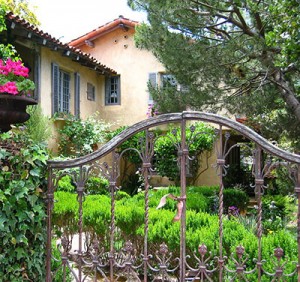 Nothing says “piss off” better than a nice fence and closed gate. To the casual thief the message is that someone thinks enough of the property to protect it with a fence and emplace a closed gate. There’s no reason for trespassing beyond the gate other than nefarious intent. Having said that, most fences are easily scaled and gates bypassed.
Nothing says “piss off” better than a nice fence and closed gate. To the casual thief the message is that someone thinks enough of the property to protect it with a fence and emplace a closed gate. There’s no reason for trespassing beyond the gate other than nefarious intent. Having said that, most fences are easily scaled and gates bypassed.
The psychological message to those passing through them is that “you’re not welcome here” and by passing beyond the boundary the thief acknowledges that he already has a couple of strikes against him. The mere act of touching a gate to open it for an unauthorized entry is objectionable to most intruders. However, once they act you can be sure they will be determined to continue until complete or caught. Once that first physical or psychological step is taken, they are committed. You’ll need some more layers.
Signs
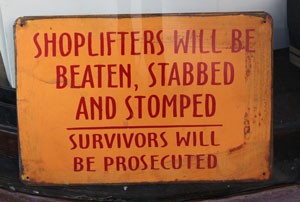 Signs are a good way to discourage casual criminals. No trespassing signs send the same message as the fence: You’re not welcome here and have no excuse for passing through. Of course there are other signs that are just as effective. A burglar alarm sign can be very effective, especially if it’s a well-known local company.
Signs are a good way to discourage casual criminals. No trespassing signs send the same message as the fence: You’re not welcome here and have no excuse for passing through. Of course there are other signs that are just as effective. A burglar alarm sign can be very effective, especially if it’s a well-known local company.
Neighborhood Watch signs can be effective, especially if other homes are within eyesight of your property. Beware of Dog signs are VERY effective. The old “Trespassers will be shot. Survivors will be shot AGAIN!” isn’t a good choice as it communicates that you have a sense of humor. Besides, such a sign would be used as evidence of premeditation if you ever actually did have to shoot an intruder. Further, the sign would indicate that you believe in gun ownership, letting the intruder conclude that your home contains something valuable: guns. OPSEC is your ally.
The Driveway
 One of the strongest indicators that the home is occupied is a car sitting in the driveway. If you’re fortunate enough to have an extra car or motorcycle, simply leave it parked in plain view in your driveway. Of course, a parked car with flat tires and a tree growing through the bumper and grass in the growing in the fender wells may not project the right message, but you get the idea.
One of the strongest indicators that the home is occupied is a car sitting in the driveway. If you’re fortunate enough to have an extra car or motorcycle, simply leave it parked in plain view in your driveway. Of course, a parked car with flat tires and a tree growing through the bumper and grass in the growing in the fender wells may not project the right message, but you get the idea.
If you do happen to have an extra car, just be sure to change its location in the driveway occasionally so it appears used. A couple of years ago when my next door neighbor’s son started driving, I noticed they didn’t have enough room in the driveway and one of them had to park in the yard. I kindly offered to let one of them park in my driveway to avoid rutting his yard. That worked out well for both of us and he never realized I was motivated by enhancing my security, not his rutted yard.
Occupancy Giveaways
There are a number of clues that can reveal you’re not home. Piles of mail falling out of your mailbox or undelivered packages sitting at your door are dead giveaways. If nothing else, stealing your mail or packages in themselves are attractive targets, especially if they can get one of your credit cards of personal information that can be exploited. If you’re away, make sure you either file a temporary stop delivery notice at your post office. Another option is to have a trusted friend or family member check your property daily and remove the mail.
With the Internet not many people still pay for a daily newspaper, but a few of us dinosaurs still remain. Newspaper deliveries are easy to turn off with a simple phone call. What you can’t control are those crappy sales papers and un-requested yellow page phone books that companies throw into your driveway or yard. You never know when they are coming and have no idea how to stop their delivery. If your luck is like mine, five minutes after you leave town for a long weekend about 20 of the damn things end up in your driveway signaling to every passerby that you aren’t home. I’m sure it’s some kind of conspiracy organized by the criminal underworld to identify unoccupied homes. Again, the safest way to avoid these is to have someone check your property daily to pick up mail and remove junk from your yard and driveway.
Property Impressions
 You’re striving for your home to have a lived in, cared for appearance. That’s more than keeping your hedges trimmed, flower beds weeded, and the grass cut. An unkempt appearance gives the impression that you don’t care about the property and somehow that conveys the psychological message that nobody cares if it gets ransacked.
You’re striving for your home to have a lived in, cared for appearance. That’s more than keeping your hedges trimmed, flower beds weeded, and the grass cut. An unkempt appearance gives the impression that you don’t care about the property and somehow that conveys the psychological message that nobody cares if it gets ransacked.
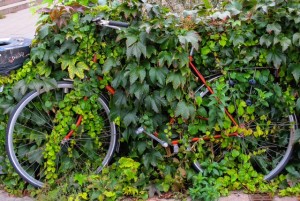 Kid’s bicycles strewn in the yard send the message that witnesses could appear any moment. The same applies to children’s toys like soccer balls or goal nets. Oddly, studies have shown that ANY movement gives the indication of occupancy. This applies even to whirly gigs or flapping flags – for some reason the test subjects seeing movement of those items assumed someone was home almost 100% of the time. Again, if you buy an old tricycle at a yard sale or leave a basketball in your driveway, move them around occasionally so they don’t look abandoned. Even stupid criminals aren’t fooled by a bicycle with tall grass or vines growing through it. Photo courtesy of Jacob Bro.
Kid’s bicycles strewn in the yard send the message that witnesses could appear any moment. The same applies to children’s toys like soccer balls or goal nets. Oddly, studies have shown that ANY movement gives the indication of occupancy. This applies even to whirly gigs or flapping flags – for some reason the test subjects seeing movement of those items assumed someone was home almost 100% of the time. Again, if you buy an old tricycle at a yard sale or leave a basketball in your driveway, move them around occasionally so they don’t look abandoned. Even stupid criminals aren’t fooled by a bicycle with tall grass or vines growing through it. Photo courtesy of Jacob Bro.
Lighting
Perimeter lighting is a strong signal that you’re serious about protecting your property. These high intensity lights are great for remote properties, but usually upset the neighbors in more suburban environments. Another downside is they are quite expensive to install and operate, requiring occasional maintenance to change burned out bulbs. If you live in a remote or secluded area however, consider installing them as a deterrent. Floodlights are especially effective if they have infrared or movement sensors attached, illuminating only when something passes within range. There’s nothing as scary as sneaking up on a house that you believe is unoccupied, only to be caught in a sudden blaze of high intensity light. The next thing you expect to hear is a gunshot directed your way. Even a steel hearted, cold blooded killer would run under circumstances like that.
Surveillance Cameras
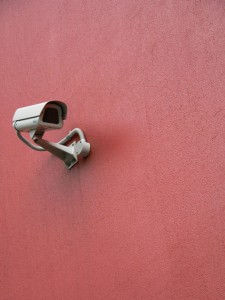 No sane criminal wants to be photographed or videoed while working. Perimeter surveillance cameras mounted at least 12’ up can be a powerful deterrent. There’s no rule that the cameras have to actually work, their mere existence is enough to deter a criminal doing his drive-by assessment. To a criminal a surveillance camera is a fast way to a free room in the nearest prison. When they see them they’ll usually move on to a softer target. The key is visibility and a convincing appearance. Mount them high so they are easily visible from the street.
No sane criminal wants to be photographed or videoed while working. Perimeter surveillance cameras mounted at least 12’ up can be a powerful deterrent. There’s no rule that the cameras have to actually work, their mere existence is enough to deter a criminal doing his drive-by assessment. To a criminal a surveillance camera is a fast way to a free room in the nearest prison. When they see them they’ll usually move on to a softer target. The key is visibility and a convincing appearance. Mount them high so they are easily visible from the street.
If the cameras are dummies, make sure that the wiring looks convincing and isn’t hanging loose. Some fake cameras come with a small solar panel mounted on top that charges an internal battery. At night, a red LED illuminates to give the impression that the camera is operating. Naturally, a real camera is preferred. If someone does break in you’ll at least have photographic evidence of attackers crossing onto your property. If you position them properly you might even get lucky and capture their license plate number or their faces. If you DO have perimeter cameras, wireless are preferable so the thieves can’t simply follow a wires back to the DVR that is recording everything. The wireless receiver and DVR should be in a concealed location, like a garage or attic, so it cannot be easily found and stolen. Many of the inexpensive security systems come with an armored, lockable box in which to store the DVR recorder, making it doubly difficult to steal even if found. Today these wireless surveillance systems with six HD cameras and a receiver/DVR sell for less than $500.
Trash cans
Most neighborhoods have a specific trash pickup day, when homeowners roll their trash can to the curb. Now I forget when pickup day is all the time and really don’t believe the absence of my can at the curb raises too many eyebrows. What may be a strong indicator that my home isn’t occupied is my empty trash can sitting at the curb all day with the lid open. If people are home they would logically see the empty can and drag it back to its place behind the house, out of sight. If someone is assessing my property for a possible break-in during the day while I’m at work, they might see the empty can several hours after the trash truck departed and notice my driveway empty. If the mailman drops off mail or a package and nobody picks it up, those things combined would be a strong indicator that the home is unoccupied. Of course, I may just be lazy… it’s his gamble.
Game Cameras
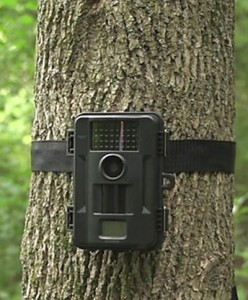 Another really cool surveillance tool is a game camera. These are motion sensing high resolution digital cameras encased in a weather proof, camouflaged casing and powered by lithium batteries. Costing less than $100 these are designed for hunters or property owners that want to obtain photos of wildlife. Mine holds a 64Gb memory chip and runs unattended for about three weeks before I have to recharge it and wipe the chip. Positioned in a concealed position at the end of your driveway or entrance they capture a series of photos as long as something is moving in their field of view.
Another really cool surveillance tool is a game camera. These are motion sensing high resolution digital cameras encased in a weather proof, camouflaged casing and powered by lithium batteries. Costing less than $100 these are designed for hunters or property owners that want to obtain photos of wildlife. Mine holds a 64Gb memory chip and runs unattended for about three weeks before I have to recharge it and wipe the chip. Positioned in a concealed position at the end of your driveway or entrance they capture a series of photos as long as something is moving in their field of view.
The resolution is so good in mine that I can even identify the car occupants through the windshield unless the sun is directly overhead. Still, the photo of the car and license plate is studio-clear. If my home is ever robbed I will at least have photographic evidence as they entered and exited my property.
Neighborhood Watch
Sadly, neighborhood watch programs are rarely implemented until a crime wave is already in progress, usually after some of your neighbors have been robbed. Still, they can be a powerful deterrent if your neighbors are vigilant. I travel to a lot of places overseas where the threat of street crime is much higher than that in the U.S. Whenever I walk around in the neighborhoods there’s always someone watching me and that seems to be a huge deterrent against criminals. In the U.S. however, everyone sits comfortably in their easy chairs in a climate-controlled house watching something on their high definition television. I could jog up and down the street naked with little chance of anyone noticing anything out of the ordinary.
Many years ago I took a surreptitious entry course as part of my training. On one graded exercise we were being extra careful, scanning each of the windows of our target house for minutes on end. As we agonized and worried about being seen the instructor stopped us and said: “Stop worrying so much about the damn windows. Looking out of windows is a random, unpredictable event. Statistically, the chance of someone looking out during your approach is practically zero”. For years I lived by that rule on warranted entries, never giving windows more than a cursory glance. I was never seen on an approach. Not once.
Americans are, for the most part, not very observant and don’t question strangers. I’ve never understood this and can only conclude that our culture is one of privacy and non-confrontation. Don’t believe it? Walk up to any stranger on the street and, with authority in your voice and a stern look on your face, say “Who are you and what are you doing here?” The person will be shocked at the confrontation and quickly begin explaining themselves to you and pulling out ID. Neighborhood watch programs need to involve some training and share “watches”, to insure someone is empowered to watch for strangers all of the time. Difficult? Yes, especially if you draw the 1000-0200 shift on a Friday night. This is the primary reason that neighborhood watch programs involve little more than a few signs posted on the street posts. Good idea, poorly implemented.
Witnesses
Criminals hate witnesses and will do their best to avoid them. When cruising around looking for targets they are aware of people walking, cutting their grass, sitting on their porch, etc. Basically anyone outside when the crime goes down is a potential witness and is to be avoided at all costs. In most cased criminals are non-confrontational and will simply pass by neighborhoods where there are potential witnesses. It’s interesting that seasonality applies to home break-ins, with more happening during the cold winter months when people are inside their warm homes. Neighborhoods with a high crime rate during the winter may have almost no crime during the summer months when people are outside enjoying the weather.
The next section is the Detection Zone, which discussed what “early warning” techniques you can use.